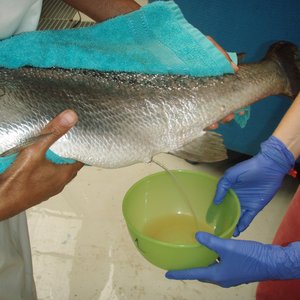Cannibalism in the early phase of growth development has been a major concern for marine finfish, including Asian seabass Lates calcarifer, as it is one of the key factors determining the economic return of commercial hatcheries.
A team of researchers explored the genetic variation in cannibalism through estimation of heritability for cannibalism rates recorded at four different time intervals (from stocking to 10d, 11 to 20d, 21 to 30d and 0-30d). The study included a total of 18,841 fish produced from 64 full- and half-sibling families.
Scientists found significant differences in cannibalism rates among families ranging from 12.97 to 55.62%. The heritability for cannibalism was low to moderate across the three statistical models used. The common full-sib effect estimated for cannibalism rates accounted for only 3 to 9% of the total phenotypic variation. Genetic correlations for the cannibalistic rates between successive measurement intervals were moderate to high and positive. Cannibalism displayed a negative (i.e., favorable) genetic association with body weight, although all the estimates had high standard errors.
“The new set of genetic parameters obtained from this study suggests that family selection for reduced cannibalism rate and improved survival rate during the fingerling phase could be effective for populations of Asian seabass,” researchers concluded.
Check out here the study.













